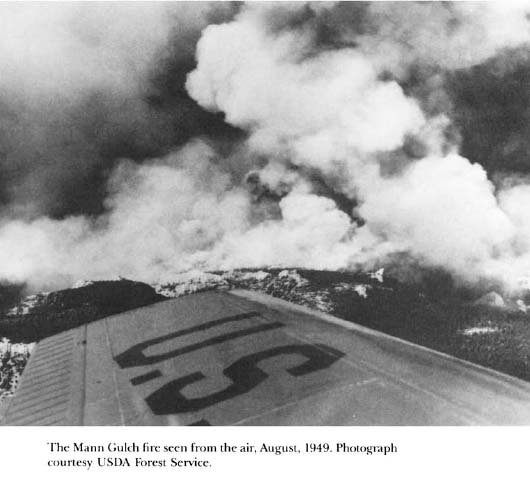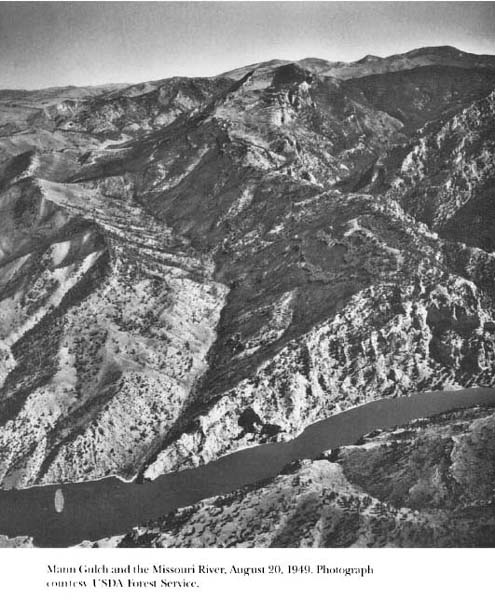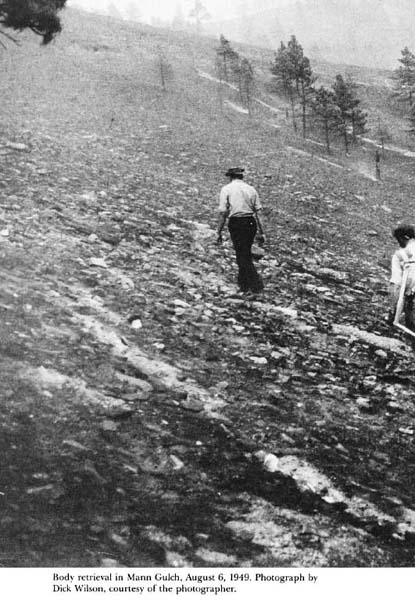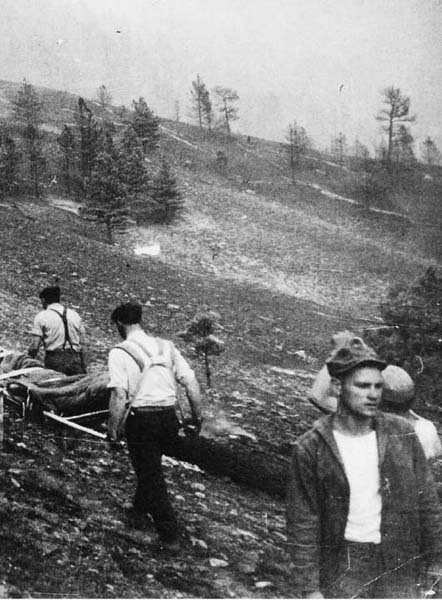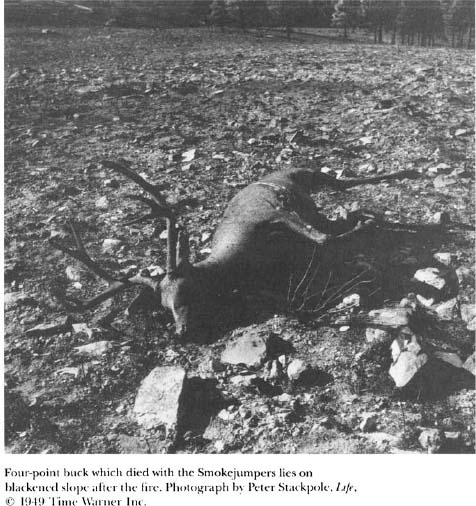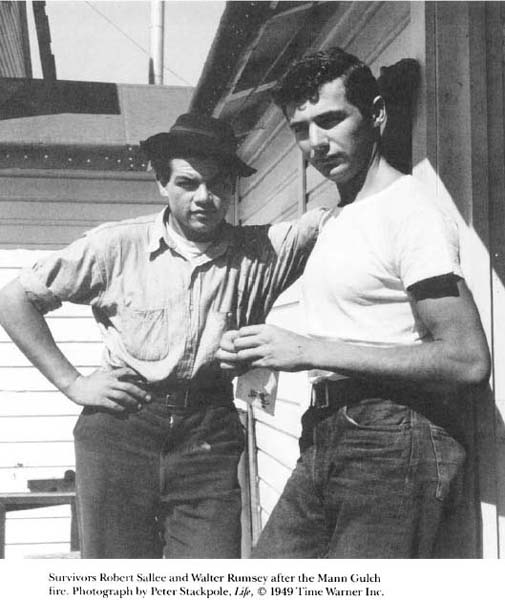Read Young Men and Fire Online
Authors: Norman Maclean
Young Men and Fire (15 page)
Then Jansson ran for help. The stars came out. Nothing moved on the game trail. The great Missouri passing below repeated the same succession of chords it probably will play for a million years to come. The only other motion was the moon floating across the lenses of Gisborne’s glasses, which at last were unobservant.
This is the death of a scientist, a scientist who did much to establish a science. On the day of his death he had the pleasure of discovering that his theory about the Mann Gulch blowup was wrong. It would be revealing if tomorrow had come and he had got all his dope together and had worked out a new Hypothesis Number One. Maybe it would have led to another theory, probably the right one.
In any case, because of him we have been able to form what is likely the correct theory. Gisborne’s portrait hangs on the staircase of the Northern Forest Fire Laboratory in Missoula, which immediately adjoins the Smokejumper base. He looks you square in the eye but is half amused as if he had caught you too attached to one of your theories, or one of his.
This was also the end of Jansson’s rescue work in Mann Gulch. He was to be transferred from the Canyon Ferry Ranger Station because he could not sleep in it or get his dog to come inside.
For a scientist, this is a good way to live and die, maybe the ideal way for any of us—excitedly finding we were wrong and excitedly waiting for tomorrow to come so we can start over, get our new dope together, and find a Hypothesis Number One all over again. And being basically on the right track when we were wrong.
Later, in thinking I was following him, I came to find out much of what I had found missing in Mann Gulch.
W
E ENTER NOW A DIFFERENT TIME ZONE
, even a different world of time. Suddenly comes the world of slow-time that accompanies grief and moral bewilderment trying to understand the extinction of those whose love and everlasting presence were never questioned. All there was to time were the fifty-six speeding minutes before the fire picked watches off dead bodies, blew them up a hillside ahead of the bodies, and froze the watch hands together. Ahead now is a world of no explosions, no blowups, and, without a storyteller, not many explanations. Immediately ahead we know there is bound to be a flare-up of public indignation and the wavering candlelight of private grief. What then? It could be a slow fade-out of slow-time until all that’s left of the memory of Mann Gulch are cracking concrete crosses on an almost inaccessible hill and a memorial tablet with the names to go with the crosses beside a picnic ground at the mouth of the next gulch upriver.
After the autumn rains changed ashes into mud slides, the story seems to have been buried in incompleteness, pieces of it altogether missing. As a mystery story, it left unexplained what dramatic and devastating forces coincided to make the best of young men into bodies, how the bodies got to their crosses and what it was like on the way, and why this catastrophe has been allowed to pass without a search for the carefully measured grains of consolation needed to transform catastrophe into tragedy. It would be natural here, looking for at least chronological continuity to the story, to follow the outcries of
the public and at the same time to try to share some part of the private sufferings of those who loved those who died. But always it would have to be conceived as possible, if an ending were sought in this direction, that there might be a non-ending. It is even conceivable that most of those closely connected with the catastrophe soon tried to see that it got lost; when the coming controversies and legal proceedings were added to all the rest of it, clearly the whole thing got so big it frightened people. They wanted it to go away and not come back.
Even so, there may somewhere be an ending to this story, although it might take a storyteller’s faith to proceed on a quest to find it and on the way to retain the belief that it might both be true and fit together dramatically. A story that honors the dead realistically partly atones for their sufferings, and so instead of leaving us in moral bewilderment, adds dimensions to our acuteness in watching the universe’s four elements at work—sky, earth, fire, and young men.
True, though, it must be. Far back in the impulses to find this story is a storyteller’s belief that at times life takes on the shape of art and that the remembered remnants of these moments are largely what we come to mean by life. The short semihumorous comedies we live, our long certain tragedies, and our springtime lyrics and limericks make up most of what we are. They become almost all of what we remember of ourselves. Although it would be too fancy to take these moments of our lives that seemingly have shape and design as proof we are inhabited by an impulse to art, yet deep within us is a counterimpulse to the id or whatever name is presently attached to the disorderly, the violent, the catastrophic both in and outside us. As a feeling, this counterimpulse to the id is a kind of craving for sanity, for things belonging to each other, and results in a comfortable feeling when the universe is seen to take a garment from the rack that seems to fit. Of course, both impulses need to be present to explain our lives and our art, and probably go a long way to explain why tragedy, inflamed
with the disorderly, is generally regarded as the most composed art form.
It should be clear now after nearly forty years that the truculent universe prefers to retain the Mann Gulch fire as one of its secrets—left to itself, it fades away, an unsolved, violent incident grieved over by the fewer and fewer still living who are old enough to grieve over fatalities of 1949. If there is a story in Mann Gulch, it will take something of a storyteller at this date to find it, and it is not easy to imagine what impulses would lead him to search for it. He probably should be an old storyteller, at least old enough to know that the problem of identity is always a problem, not just a problem of youth, and even old enough to know that the nearest anyone can come to finding himself at any given age is to find a story that somehow tells him about himself.
When I was a young teacher and still thought of myself as a billiards player, I had the pleasure of watching Albert Abraham Michelson play billiards nearly every noon. He was by then one of our national idols, having been the first American to win the Nobel Prize in science (for the measurement of the speed of light, among other things). To me, he took on added luster because he was the best amateur billiards player I had ever seen. One noon, while he was still shaking his head at himself for missing an easy shot after he had had a run of thirty-five or thirty-six, I said to him, “You are a fine billiards player, Mr. Michelson.” He shook his head at himself and said, “No. I’m getting old. I can still make the long three-cushion shots, but I’m losing the soft touch on the short ones.” He chalked up, but instead of taking the next shot, he finished what he had to say. “Billiards, though, is a good game, but billiards is not as good a game as chess.” Still chalking his cue, he said, “Chess, though, is not as good a game as painting.” He made it final by saying, “But painting is not as good a game as physics.” Then he hung up his cue and went home to spend the afternoon painting under the large tree on his front lawn.
It is in the world of slow-time that truth and art are found as one.
T
HE HILL ON WHICH THEY DIED
is a lot like Custer Hill. In the dry grass on both hills are white scattered markers where the bodies were found, a special cluster of them just short of the top, where red terror closed in from behind and above and from the sides. The bodies were of those who were young and thought to be invincible by others and themselves. They were the fastest the nation had in getting to where there was danger, they got there by moving in the magic realm between heaven and earth, and when they got there they almost made a game of it. None were surer they couldn’t lose than the Seventh Cavalry and the Smoke-jumpers.
The difference between thirteen crosses and 245 or 246 markers (they are hard to count) made it a small Custer Hill, with some advantages. It had helicopters, air patrol, and lawsuits. It had instant newspaper coverage and so could heighten the headlines and suspense as the injury list changed from three uninjured survivors, two men badly burned, and the rest of the crew missing, to the final list on which the only survivors were the first three. The headlines flamed higher as all the burned and all the missing proved dead.
The Forest Service knew right away it was in for big trouble. By August 7 chief forester Lyle F. Watts in Washington appointed an initial committee to investigate the tragedy and to report to him immediately, and on August 9 the committee flew over the area several times, went back to Mann Gulch by boat, and spent three hours there. Like General Custer himself, who liked to have reporters along, the investigating committee took with them a crew of reporters and photographers from
Life
magazine. The lead article of
Life’s
August 22, 1949, issue, “Smokejumpers Suffer Ordeal by Fire,” runs to five pages and includes a map and photographs of the fire, the funeral, and a deer burned to death, probably the deer that Rumsey and Sallee saw come out of the flames and collapse while they were ducking from one side of their rock slide to the other.

